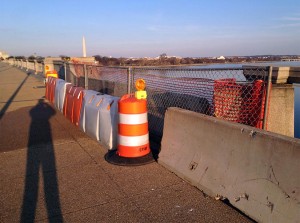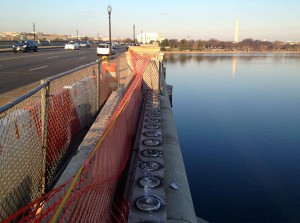Last night, around 10:00 p.m., an SUV somehow crashed through a barrier on the south side of the Memorial Bridge and landed in the Potomac River.
The driver, the SUV’s lone occupant, escaped the watery wreck and was transported to a local hospital with non-life-threatening injuries. Charges are now pending against the driver, according to U.S. Park Police spokesman Sgt. Paul Brooks.
If you’ve ever feared making a wrong turn and driving off the side of a bridge, AAA Mid-Atlantic has some potentially helpful tips for you. From a press release:
Although they are considered worst-case scenarios, such crashes rarely happen, safety officials and experts say. But that’s of little consolation to local drivers when their vehicle suddenly goes deep six or becomes a leaking boat. What you do and how you react within moments of the crash into the abyss will determine whether you live or die in a watery grave, the auto club advises. “Add darkness and near freezing water, and your chances of escape have greatly diminished,” safety experts warns.
“Although less than one-half of one percent of all automobile crashes involves a vehicle being submerged under water, it is still a very frightening situation to motorists and their terrified passengers, especially young children and the elderly,” said John B. Townsend II, AAA Mid-Atlantic’s Manager of Public and Government Affairs. “Previous research shows that between 400 to 600 persons lose their lives each year in the United States, as their vehicles plummet into a canal, river, or a ditch for that matter.”
Annually, almost ten percent of all drowning deaths in the United States can be attributed to being submerged in a car. If children are in the car, the driver or the adult should focus on getting the children out safely first and keeping them from panicking during the petrifying ordeal. In most crashes of this nature, the heaviest end of the deep-sixed vehicle – usually the end with the engine – will begin sinking first, pulling the car down at an angle, notes Popular Mechanic. That is, unless the water is 15 feet or deeper. In that case, the vehicle may land on its roof, compounding the dangers and risks for the occupants.
Although most vehicles will float for three or four minutes before they start sinking due to the surprising buoyancy of the vehicle in deep water and depending upon on the airtightness of the vehicles, time is still of the essence, advises AAA Mid-Atlantic. The overarching concern is getting to dry land as quickly as possible. Your safety and the lives of your passengers depend upon that.
So, the first key to surviving such a mishap is remaining calm, according to safety experts. Underscoring this, the National Safety Commission puts it this way: “The first and most important thing to remember, if your vehicle is submerged, is to remain CALM – easier said than done-but it’s the most important thing you can do to stay alive.” However, the experts tend to vary on their tips. For example, the brothers Magliozzi, Tom and Ray, of NPR’s “Car Talk” say: “The correct way to get out of a sinking car is to float in the cabin until water is within about 2 inches of the roof. At that time pressure in and outside the car will be equal and it will be easy to open the door and swim out.”
For safety’s sake and to avoid confusion, first responders and the National Safety Commission offer the following tips when your vehicle plunges into the fathoms below:
- Don’t panic. Once your car hits the water it will not sink immediately (You will have at least one or two minutes before the car begins to sink, safety experts say).
- If possible, jump out while car is on surface.
- If your car is still floating, roll down the window and unbuckle your seat belt to escape.
- If your car is submerged, safety experts suggest remaining buckled up while you break the driver or passenger’s side window to escape.
- Allow the pressure of the water to equalize inside the sodden vehicle before attempting to open the doors or windows. Water weighs 62.4 lbs. per cubic foot.
- Move toward rear of vehicle where the air bubble is forming.
- Water pressure against the water-logged doors will make opening the doors very difficult until the pressure inside of the vehicle and outside of the vehicle are equal.
- Open your windows to allow yourself and your passengers to escape (Contrary to popular opinion, the “power windows won’t stop working within seconds after impact.” The power can stay on as along as 10 minutes).
The nightmarish crash from the Memorial Bridge is a reminder to motorists of the importance of carrying and keeping a sharp tool, such as a Philips screwdriver or a spring-loaded center punch, in their glove compartment or in the cabin of their vehicle. The tool is a life-saver. Here’s why: it allows you to break the tempered glass to extricate yourself and your passengers from the sinking vehicle. Other salient tips include:
- If the windows are blocked, try to push the windshield or rear window out with your feet or shoulder.
- Rescue the children or passengers who need assistance to help them to escape. If children are in the sinking or submerged car, unbuckle their seatbelts and or child passenger seat, starting with the oldest child first.
- Safeguard the kids. Push the children out of the vehicle ahead of you.
- Always keep a window-breaking tool in your vehicle in an easily accessible location, safety experts suggest.
- Remove heavy clothing before attempting to swim to safety.
- Swim to the surface as safely and quickly as possible (swim in the direction of the current if you’re in deep water).
- Push off for quick rise to the surface.
- If you can’t swim try to float. Use your body’s natural buoyancy to float. Make sure to raise your head to breathe.
- Call for medical attention as quickly as possible.
Ironically, just last week crews from the Federal Highway Administration reportedly began an “extensive inspection of the deck of the iconic 80-year-old Arlington Memorial Bridge, a process that is expected to continue through March 5. In September the 2,163 feet long bridge underwent a two month long renovation, costing $788,375, to repair and replace its entire driving surface.
Photos courtesy Mark P.
Students Head Back to School — Today is the first day of school for nearly 23,000 Arlington Public School students. School start times vary in Arlington, from 7:50 a.m. for middle schools to 9:24 a.m. for the H-B Woodlawn Secondary program. Superintendent Dr. Patrick Murphy has created a back-to-school video for students and parents. Arlington County, meanwhile, is urging drivers to be especially cautious on the roads this morning.
AAA Warns of ‘Terrible Traffic Tuesday’ — AAA Mid-Atlantic is warning of “the mother of all gridlock” today, a day the organization has dubbed “Terrible Traffic Tuesday.” With students heading back to school and workers back from summer vacations, AAA expects traffic congestion to spike 26 percent compared to mid-summer. Adding to the congestion in Arlington will be the 146 yellow APS school buses on the roads. [AAA Mid-Atlantic, Bethesda Now]
Special Election Today — Voters in Virginia’s 45th House of Delegates District will head to the polls today in the special election to replace Del. David Englin, who resigned following the admission that he had an extramarital affair. The three candidates in the race are Tim McGhee (R), Rob Krupicka (D) and Justin Malkin (L). Only five electoral precincts in Arlington are included in the 45th District: Aurora Hills, Fairlington, Abingdon, Oakridge, and Shirlington. [Arlington County]
Flickr pool photo by Maryva2
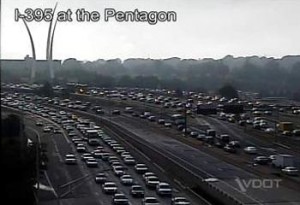 About 800,000 D.C. area residents are expected to hit the roads, rails and airports this Labor Day weekend, according to a travel forecast by AAA Mid-Atlantic.
About 800,000 D.C. area residents are expected to hit the roads, rails and airports this Labor Day weekend, according to a travel forecast by AAA Mid-Atlantic.
Despite quickly rising gas prices — jumping at least 40 cents in the past two months — AAA says this will be the busiest Labor Day weekend in terms of travel since 2008 and the start of the recession. It’s the third summer holiday travel period this year projected to set a post-recession record.
Some 799,900 Washington area residents are expected to travel more than 50 miles for Labor Day, up 3.5 percent from 2011. Of those travelers, 86.8 percent are expected to travel by car, 7.9 percent by air, and 5.3 percent by other means.
AAA is cautioning travelers to check weather forecasts before they leave, however, as Tropical Storm Isaac continues to head north from the Gulf coast
“As they prepare to embark on their Labor Day vacation trips, local residents are urged to stay abreast of local forecasts both at their departure city and at their points of destinations,” said Lon Anderson, AAA Mid-Atlantic’s Managing Director of Public and Government Affairs. “While it is challenging to predict the impact that Hurricane Isaac may have on Labor Day travel plans, tropical storms and hurricanes, like this one, typically do not negatively influence travel at the national level.”
“It’s very encouraging that the total number of 2012 Labor Day holiday travelers across the nation and the Washington metro region is expected to reach a new post-recession high,” Anderson continued. “Even more encouraging, this is a travel ‘trifecta’ or the third such increase in holiday travel during this summertime. Clearly, Americans and Washingtonians are trying to put the recession behind them.”
According to AAA and the Associated Press, Thanksgiving airfare and the cost of filling a tank of gas are both up 20 percent this year.
Nonetheless, 42.5 million people nationwide are expected to hit the roads, rails and airways for Thanksgiving — the highest number since the beginning of the recession. Here in the Washington region, more than 1 million people are expected to travel for the holiday, and the vast majority of them will be getting to their destination via highways, according to AAA Mid-Atlantic.
Are you among the intrepid Thanksgiving travelers?
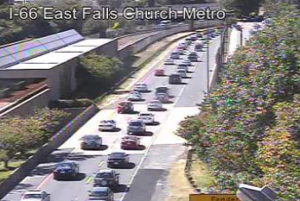 According to AAA Mid-Atlantic, more than 1 million people in the D.C. area are expected to head out of town for the holiday.
According to AAA Mid-Atlantic, more than 1 million people in the D.C. area are expected to head out of town for the holiday.
That’s a 11 percent increase over least year and the highest number of area residents heading out for Thanksgiving since 2007.
“The Washington metro area has one of the strongest economies in the nation, and as evidence of this, we will likely see a double digit up-tick in the number of area residents traveling 50 miles or more from home for the holiday,” AAA Mid-Atlantic spokesperson John B. Townsend II said in a statement.
Also driving Washington area travel is the fact that “only 40 percent of D.C. residents were actually born in D.C.,” according to AAA.
Surprisingly, a whopping 95.4 percent of those leaving town are expected to do so in a car. Only 3.4 percent are flying, and only 1.2 percent are taking a bus, train or boat.
How are you going home this year?
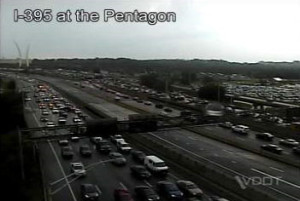 The way AAA Mid-Atlantic tells it, the Tuesday after Labor Day is one of the year’s most “mind-numbing, soul-robbing” days traffic-wise.
The way AAA Mid-Atlantic tells it, the Tuesday after Labor Day is one of the year’s most “mind-numbing, soul-robbing” days traffic-wise.
The automobile association says that DC-area drivers should “brace themselves” for the one-two punch of kids going back to school and workers returning from summer vacations today. After a two-month respite from the worst of the area’s traffic, things should be back to gridlock-as-usual — a “dreadful day of reckoning” known as “Terrible Traffic Tuesday.”
AAA notes that about 1.5 million local commuters drive to work solo on any given workday. The group says that despite the increasing number of people working from home, Metro’s recent troubles and the new peak-of-the-peak fare may be putting more cars on the road.
“With the recent fare increases and number of breakdowns, more and more people could be shying away from some of the area’s mass transit alternatives,” said AAA Mid-Atlantic spokesperson John Townsend.


